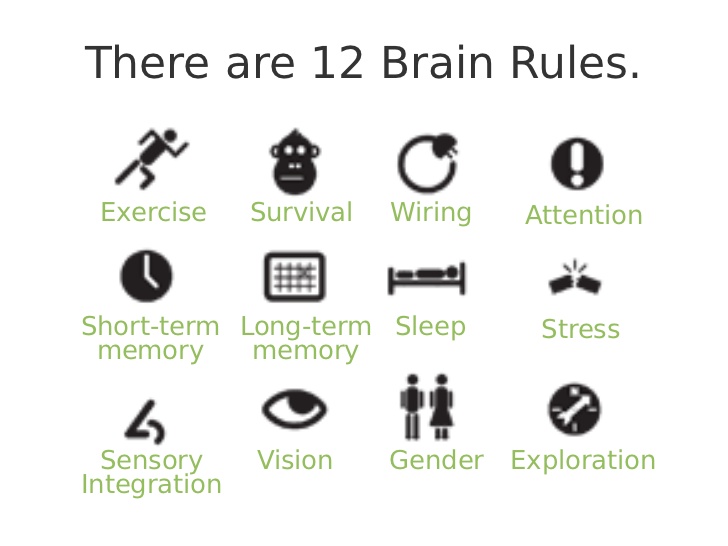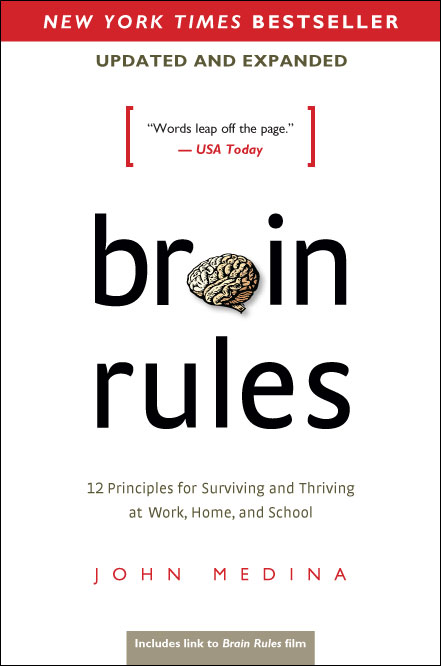Earlier in the year, I met with a friend, former lacrosse coach & one-time housemate of mine, for supper near his new work place at Rutgers University, New Brunswick. John (Payne) is a cerebral fellow & has flirted with several careers in his professional life, including teaching & coaching. So, when he suggested I read a book about neuroanatomy, neuroscience & how it relates to our ability to learn, I immediately took note.
With our latest training camp out of the way, we have arrived in Zadar, Croatia, for a four-day tournament & as I knew there would be travel time to take advantage of, I packed the aforementioned book. I am enjoying my reading at the moment & have been getting through a number of texts in recent weeks, several of which are positively influencing my work. This book is definitely worth a mention.
“Brain Rules” is written by Dr. John Medina, a developmental molecular biologist & affiliate Professor of Bioengineering at the University of Washington School of Medicine. Dr. Medina’s work focusses on the genes involved in the development of the human brain & the genetics of psychiatric disorders.
The book discusses the “12 Brain Rules” that Dr. Medina identifies as influencing how the brain reacts to & organises information, related to what is known about neuroscience & neuroanatomy.

Some of these rules are no surprise. For example, Rule 1 declares that exercise improves cognitive abilities, problem solving & memory capabilities due to the increased blood flow, which supplies the brain with more fuel, more oxygen & stimulates the protein that facilitates neuronal connection.
What really hooked me though, is Medina’s ability to explain neuroanatomy in a language that didn’t suggest I should use the text as a cure for insomnia. Not only that but his salient points are illustrated with memorable stories & considerations for how to employ optimal learning strategies in real-life learning environments.
As such, I have already started rewriting a couple of my presentations to incorporate his tips, with the aim of making them more audience-friendly. I also found myself reading his book in a different manner to test his proposals for optimising my information retention. This is facilitated in a consistent manner by watching the accompanying videos that are available on the author’s own website.
So if I were to identify my 3 key points that I took from the text, what would they be? Given the actions I have already taken, I would suggest:
- Rule 4 states that the brain’s ability to maintain attention on any one topic is limited to about ten minutes of sustained exposure. Not only that but the introduction to the topic has to make an impact, which is more effective if it stimulates an emotional response, otherwise, some people will switch off much earlier.
That said, by chunking an overall topic into 10 minute, independent but linked units, each set up by a compelling narrative, drawing on an emotion, this capacity is retained throughout a 50 minute presentation. This is definitely going to influence my delivery style moving forward.
- Rules 5 & 6 address how the brain processes information & retains it as a short term memory, before potentially continuing to refine that information as it is committed to long-term memory over the following years (yes, you read that correctly…years!).
By tweaking the manner in which I am digesting the information & the environment in which I am absorbing it in, I have already enhanced my uptake of the information in the book & a couple of journal articles I read on the journey.
I am now going to revise the material in another couple of formats to see if my long-term retention is improved, as Dr. Medina suggests it should be. The Brain Rules website has videos that summarise each chapter & I will also write my customary review for my own records.
If this is successful, the manner in which I operate clinically will change to take advantage of these findings, which will involve being more deliberate in how I present information to athletes & how I revisit it with them, with the aim of improving compliance & quality of reproduction.
- Rule 7 highlights the impact that sleep has on learning & how sleep deprivation impairs the process of committing information to memory. Furthermore, Dr. Medina relates the balance of wakefulness & sleep to the underlying neuroscience, clearly explaining why we hit a mid-afternoon “nap zone”.
Whilst I have read a lot about sleep deprivation & the performance benefits of sleep supplementation for athletes, I hadn’t previously realised the physiology that underpins it. It is quite clear that everyone’s executive function, reasoning, attention & even motor dexterity would be boosted with an afternoon nap, which would improve overall productivity.
The Japanese have taken this seriously for several years, installing sleep pods in offices & airports. Teams such as Manchester United & AC Milan have followed suit & it is something I am keen to explore further because the science behind the practice is clear - there’s no point in fighting the “nap zone”.
Another take away point was that if you can’t fit a nap into your daily schedule (although if Winston Churchill, JFK, Ronald Reagan, Thomas Edison, Lyndon B. Johnson & Napoleon Bonaparte could all fit afternoon snoozes into their routine, then we should be able to), at least avoid organising important meetings or brainstorming sessions around this time.
In addition, there were really important take-away points on the gender differences that should be considered in learning; the power of curiosity; the effects of chronic stress on learning & the benefits of stimulating more of the senses during a learning exercise.

In summary, not only was the book an extremely entertaining read, that made me question many of my approaches to teaching, learning & relationship building, Dr. Medina was able to provide practical ideas that will really improve my productivity as I introduce them into both my personal life & working life.
To find out more about Brain Rules & the author, Dr. John Medina, click on the link below. Here, you can watch some of the videos, read excerpts from the text & even order the book.

